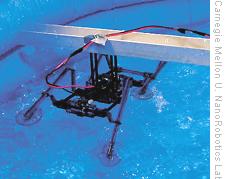 |
Researchers at Carnegie Mellon University's NanoRobotics Lab manufacture gecko-type foot hairs for Waalbot, the robotic prototype
|
A
robotics team at Carnegie Mellon University in Pittsburgh, Pennsylvania, is
tackling real world problems by studying the natural world for
inspiration.
In
the university's NanoRobotics Lab
mechanical engineering graduate student Mike Murphy takes his cues from
nature. Murphy's guide is the gecko, a
tropical lizard with sticky feet. He says it's the millions of microscopic
hairs on the gecko's footpads, which actually connect with the molecular bonds
of the surface material, that give the lizard its remarkable climbing
ability. "By studying these
animals we can create synthetic versions of their adhesives and put them on robots."
 |
| Crested gecko adhering to smooth acrylic |
The
tri-legged climbing Waalbot
fits into the palm of Murphy's hand.
Its microscopic polymer foot hairs give it some of the gecko's climbing
power, although, Murphy, who has positioned a crash pad for the robot's fall,
says his version is on a steep learning curve.
The Waalbot can adhere better to a smooth surface than a rough one he
says and adds that another challenge is keeping the adhesive pads clean.
"Our adhesive pads pick up contaminants from the climbing surfaces."
Geckos
don't have that problem.
![Carnegie Mellon University graduate students [l-r] Onur Ozcan, Steven Floyd and Mike Murphy in the NanoRobotics lab Carnegie Mellon University graduate students [l-r] Onur Ozcan, Steven Floyd and Mike Murphy in the NanoRobotics lab](https://webarchive.library.unt.edu/eot2008/20081007043815im_/http://www.voanews.com/english/images/4inlab.jpg) |
| Carnegie Mellon University graduate students [l-r] Onur Ozcan, Steven Floyd and Mike Murphy in the NanoRobotics lab |
The
robot is designed to carry a payload, which Murphy says could be a camera or a
mobile relay network for a computer system. He envisions applications that
range from inspection and surveillance to work in space. "On the space
shuttle, you could have a robot that climbs around, looks for damage and even
repairs it."
Murphy's
Waalbot shares lab space with Water Runner. This robot is modeled after the speedy
basilisk lizard, which walks on water at speeds of 1.5 meters per second in the
rain forests of Central and South America.
Graduate student Steven Floyd says the basilisk stays afloat in the way
it slaps and strokes the water.
 |
| The Water Runner robot mimics the Basilisk lizard, a member of the Iguana family |
"The idea behind it is that the basilisk
lizard can run on water and run on land and it uses similar motion for
both."
The
boxy-looking, remote-controlled robot has a motor in each of its four skinny
legs. Floyd says while Water Runner
would make a great toy, its ability to operate on land and water broadens its
use especially in partially flooded environments and marshland.
![The robotic Water Strider may someday be deployed to measure contaminants in waterways and dams<br />[Credit: Carnegie Mellon University NanoRobotics Lab] The robotic Water Strider may someday be deployed to measure contaminants in waterways and dams<br />[Credit: Carnegie Mellon University NanoRobotics Lab]](https://webarchive.library.unt.edu/eot2008/20081007043815im_/http://www.voanews.com/english/images/3-waterstriderdark_1.jpg) |
The robotic Water Strider may someday be deployed to measure contaminants in waterways and dams
[Credit: Carnegie Mellon University NanoRobotics Lab] |
Graduate
student Onur Ozcan from Turkey works nearby on Water Strider.
He says this robotic prototype is fashioned after the pond skimmer, an insect
that can glide over water with little drag or friction. "If we can mimic
this behavior with this tiny robot then it can be a big success for us. We can
use it to measure the quality of water on dams or on any water source."
Ozcan
says as he works on mechanical problems in the NanoRobotics Lab he and his
colleagues continue to marvel at the beauty of the natural world and the
mechanics of the animals that inhabit it.

